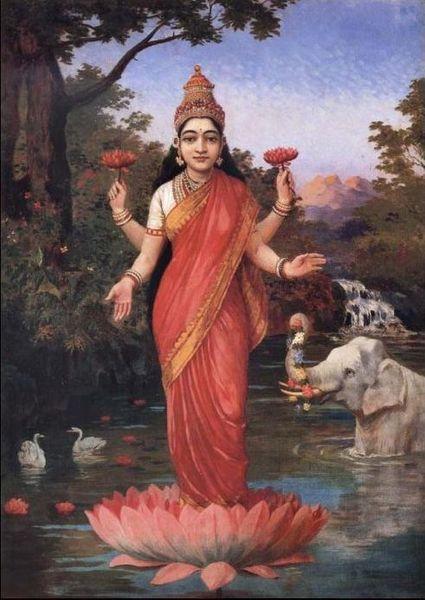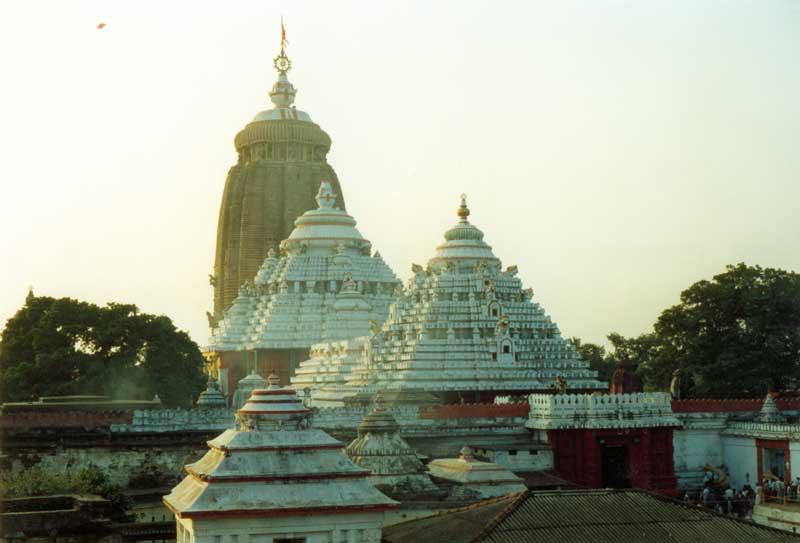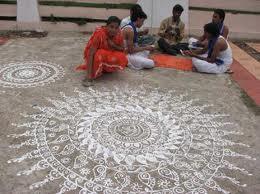Goddess Laksmi and Cultural Traditions of Rice: Implications for the Status of Women
archive

Goddess Laksmi and Cultural Traditions of Rice: Implications for the Status of Women
There is worldwide concern at the falling proportion of girls among youth populations in developing countries, especially in China and India which are otherwise making news as rising economies. Recent census figures in both countries present a still increasing gender gap and thus an alarming trend toward an expanding ‘female deficit’ over the decades. A deeper analysis of this phenomenon indicates that it is related in no small measure to the non-recognition of the economic value of women’s contribution to production processes and household work.
A glance into traditions of economy and culture can provide clues to solving this problem. The historical experiences of Asian societies, especially rice-growing regions, show that even in a prevailing patriarchal milieu, recognition of women’s participation in the agricultural process and household management has contributed to enhancing the status of women. This is illustrated by study of a social reform initiative in Eastern India which shaped popular consciousness in the sixteenth century through a literary creation rooted in the myth of goddess Laksmi, in which practices from the rural economy and the household helped convey a socially transformative message whose ritual observance continues on a mass scale until today and laid the foundation for a relatively more egalitarian and gender-just society.

The 16th-century regionalization of Indian culture accompanied the rise of great kingdoms and the unfolding of religious transformations. Regional languages challenged the dominance of Sanskrit by producing a rich variety of literature, while the great epics such as the Ramayana and Mahabharata were translated into local languages and adapted to local cultures. The Laksmi Purana (Laksmi Vratakatha) reflects this tendency. The purana genre is a popular Indian scripture, particularly in the tradition of Hinduism, that usually depicts the story of a goddess or god and sometimes imparts a radical message to the masses of common people. The Bhakti movement provides the example of social reformers like Balaram Das, who wrote the Laksmi Purana.
This wave of the sixteenth century Bhakti movement in Odisha differed considerably from earlier phases insofar as it provided a social and philosophical orientation to the movement. Its two main sects challenged the existing patriarchal and caste hierarchy and the subordinate role of women by recruiting members from all castes, and advocating that the status of any individual be based on work, rather than birth.
The goddess Laksmi, known traditionally as the consort of Lord Vishnu, is regarded in Odisha as the consort of Lord Jagannath and resides with her husband within the boundaries of his temple at Puri while enjoying her own separate temple in his sacred precinct. The twelfth-century Jagannath temple is still considered the most important in Odisha since the god has always been recognized as the main deity of the royal family and the region itself.
In the sixteenth century different sects of the Bhakti movement worshipped Lord Jagannath, who was regarded as the incarnation of both Vishnu and Krishna. Thus the Jagannath temple became an important site for the reformers to impart their radical social messages. Balaram Das used the precinct of the temple to recite his purana among the women.

Laksmi is also known widely as Annapurna, provider of the bounty of rice. Examining the way Laksmi is conceptualized reveals her links to the cultural practices of rice cultivation. Women generally uphold cultural practices, and rice culture is no exception. The unique place of this grain in shaping the lifestyle of the people whose sustenance and livelihood depend on it is seen in the fact that only rice is associated with a goddess – Laksmi. In rice-cultivating regions in India, each stage of production is carried out on an auspicious day and rituals are performed. Odisha, a predominantly rice-producing state, knows various rituals marking stages of rice cultivation such as ploughing, transplantation, harvesting, and storage. Thus rice and Laksmi are interchangeable concepts in local imagination, and in the rural areas rituals have been performed from the sixteenth century until today. Women try to observe these rituals with devotion lest the displeasure of the goddess affect the harvest and bring starvation, concerns that ensure care and attention to the process of production. During the annual worship of Laksmi, women still recite the purana written by Das.
Laksmi is also known widely as Annapurna, provider of the bounty of rice. Examining the way Laksmi is conceptualized reveals her links to the cultural practices of rice cultivation.
The purana story reads like this. Once Laksmi went out of the temple of Puri in disguise to observe devotees worshipping her on her designated day. She was disappointed to find only one untouchable woman worshipping. Being pleased with her, Laksmi went to her house and granted her a number of boons. On returning to the temple her husband Jagannath, provoked by his brother Balaram, rebuked her and demanded that she leave the temple since by visiting an untouchable household she had become an out-caste. Offended by the lack of appreciation of her visit to a devotee irrespective of caste, she cursed the brothers to be deprived of food until she fed them. She vowed to teach them a lesson by showing her own capabilities, and since she was in charge of the all the food grains of the mortal world as well as household affairs, she saw to it that the brothers went hungry. She resorted to this punishing act also realizing that otherwise men of the mortal world would not care for their women.
Deprived of food, the brothers roamed the land until they finally landed on the doorstep of the household where Laksmi was living. Laksmi fed them, declaring herself an untouchable. Realizing his fault, Jagannath promised her autonomy to move freely among her devotees without caste barriers, and allowed members of all castes to share offerings to him without stigmatization as out-caste. Jagannath receives offerings of cooked food to this day.
It has been observed that the girl child has a better chance to survive in rice-farming areas compared to areas where wheat cultivation dominates.
As mentioned in the story, women were in charge of managing the food grains at the household level. Women’s participation in the reality of agriculture work today remains obvious in rice-farming areas. Scholars from Boserup (1970) to Joan Menchor (1978) and Pranab Bardhan (1974) have all pointed out that women contribute significantly to almost every stage of rice cultivation. It has been observed that the girl child has a better chance to survive in rice-farming areas compared to areas where wheat cultivation dominates. Evidence also suggests that both the infant mortality ratio and the gender ratio (males per hundred females) are lower, thus less adverse to women, in the rice-producing regions as compared to wheat producing.

Thus it is that the Bhakti movement of the sixteenth century left traces visible to this day in rural Odisha. In the purana story not only does Laksmi assert her autonomy but, more importantly, she challenges dominant caste discriminations and raises the status of women’s labor. In the present global context some important lessons can be derived from this example. For although India and China have adopted policy measures to protect the girl child, year after year the proportion of female children continues to decline despite growing signs of social and economic prosperity.
Such trends seem to indicate that cultural attitudes and perceptions may now be one of the greatest obstacles that policymakers and reformers confront. Although they should continue to advocate policies that increase job opportunities for women, they must also turn their attention to developing strategies that enhance the perceived value of women’s contributions to economy and society. Local mythologies may offer fertile ground for such activism, as the Laksmi Purana so eloquently suggests.
Bardhan, Pranab (1974). ‘On Life and Death Question.’ Economic and Political Weekly, Special Number, August.
Boserup, Ester (1970). Women’s Role in Economic Development, London, Allen and Unwin.
Menchor, Joan (1978). Agriculture and Social Structure in Tamil Nadu: Past Origins, Present Transformation and Future Prospects. New Delhi, Allied Publisher Ltd.
Mohanty, Bidyut (2008). “Status of Women in an agrarian Economy: Deconstruction of Oriya Laksmi vrata katha.” In Shimkhada, Deepak and Phyllis Herman, The Constant and Changing Face of Goddesses: The Goddess Tradition of Asia. Newcastle upon Tyne, Cambridge Scholars Publishing.
Mohanty, Satya P (2008). “Alternative Modernities and Medieval Indian Literature: The Oriya Lakshmi Purana as a Radical Pedagogy.” diacrities /Fall 2008
Tags: Culture & Language, Economy, Human Rights, Imaginaries, India, Religion, Social Movements, South Asia



